 Inflation has surged worldwide as countries have come out of their COVID-19 lockdowns. The increases in prices combined with supply-chain problems has raised questions of what will happen to future prices and whether it will feed further inflation cycles.
Inflation has surged worldwide as countries have come out of their COVID-19 lockdowns. The increases in prices combined with supply-chain problems has raised questions of what will happen to future prices and whether it will feed further inflation cycles.
Inflation targeting
Inflation is a key contributor to instability in an economy. It measures the rate of increases in prices over a given period of time and indicates what will happen to the cost of living for households. Because of its importance, many central banks aim to keep inflation low and steady by setting a target. The Bank of England, the Federal Reserve, and the European Central Bank all aim to keep inflation low at a target rate of 2 per cent.
Inflation-rate targeting has been successfully practised in a growing number of countries over the past few decades. However, measures to combat rising inflation typically contract the economy through reducing real aggregate demand (or at least its rate of growth). This is a concern when the economy is not experiencing a strong economic performance.
Current outlook
 Globally, rising inflation is causing concern as a surge in demand has been confronted by supply bottlenecks and rising prices of energy and raw materials. As the world emerges from the COVID-19 lockdowns, global financial markets have been affected in recent months by concerns around inflation. They have also been affected by the prospect of major central banks around the world being forced into the early removal of pandemic support measures, such as quantitative easing, before the economic recovery from the coronavirus is complete.
Globally, rising inflation is causing concern as a surge in demand has been confronted by supply bottlenecks and rising prices of energy and raw materials. As the world emerges from the COVID-19 lockdowns, global financial markets have been affected in recent months by concerns around inflation. They have also been affected by the prospect of major central banks around the world being forced into the early removal of pandemic support measures, such as quantitative easing, before the economic recovery from the coronavirus is complete.
The Chief Economist at the Bank of England has warned that UK inflation is likely to rise ‘close to or even slightly above 5 per cent’ early next year, as he said the central bank would have a ‘live’ decision on whether to raise interest rates at its November meeting. Although consumer price inflation dipped to 3.1 per cent in September, the Bank of England has forecast it to exceed 4 per cent by the end of the year, 2 percentage points higher than its target. UK banks and building societies have already started to increase mortgage rates in response to rising inflation, signalling an end to the era of ultra-low borrowing costs and piling further pressure on household finances.
In the USA, shortages throughout the supply chains on which corporate America depends are also causing concern. These issues are translating into widespread inflationary pressure, disrupting operations and forcing companies to raise prices for customers. Pressure on every link in the supply chain, from factory closures triggered by COVID-19 outbreaks to trouble finding enough staff to unload trucks, is rippling across sectors, intensifying questions about the threat that inflation poses to robust consumer spending and rebounding corporate earnings. Reflecting concern over weaker levels of global economic growth despite rising inflationary pressures, US figures published at the end of October showed the world’s largest economy added just 194 000 jobs in September, far fewer than expected.
There are also fears raised over high levels of corporate debt, including in China at the embattled property developer Evergrande, where worries over its ability to keep up with debt payments have rippled through global markets. There are major concerns that Evergrande could pose risks to the wider property sector, with potential spill-overs internationally. However, it is argued that the British banking system has been shown in stress tests to be resilient to a severe economic downturn in China and Hong Kong.
Central bank responses
The sharpest consumer-price increases in years have evoked different responses from central banks. Many have raised interest rates, but two that haven’t are the most prominent in the global economy: the Federal Reserve and the European Central Bank. These differences in responses reflect differing opinions as to whether current price increases will feed further inflation cycles or simply peter out. For those large central banks, they are somewhat relying on households keeping faith in their track record of keeping inflation low. There is also an expectation that there are enough underutilised workers to ensure that wage inflation is kept low.
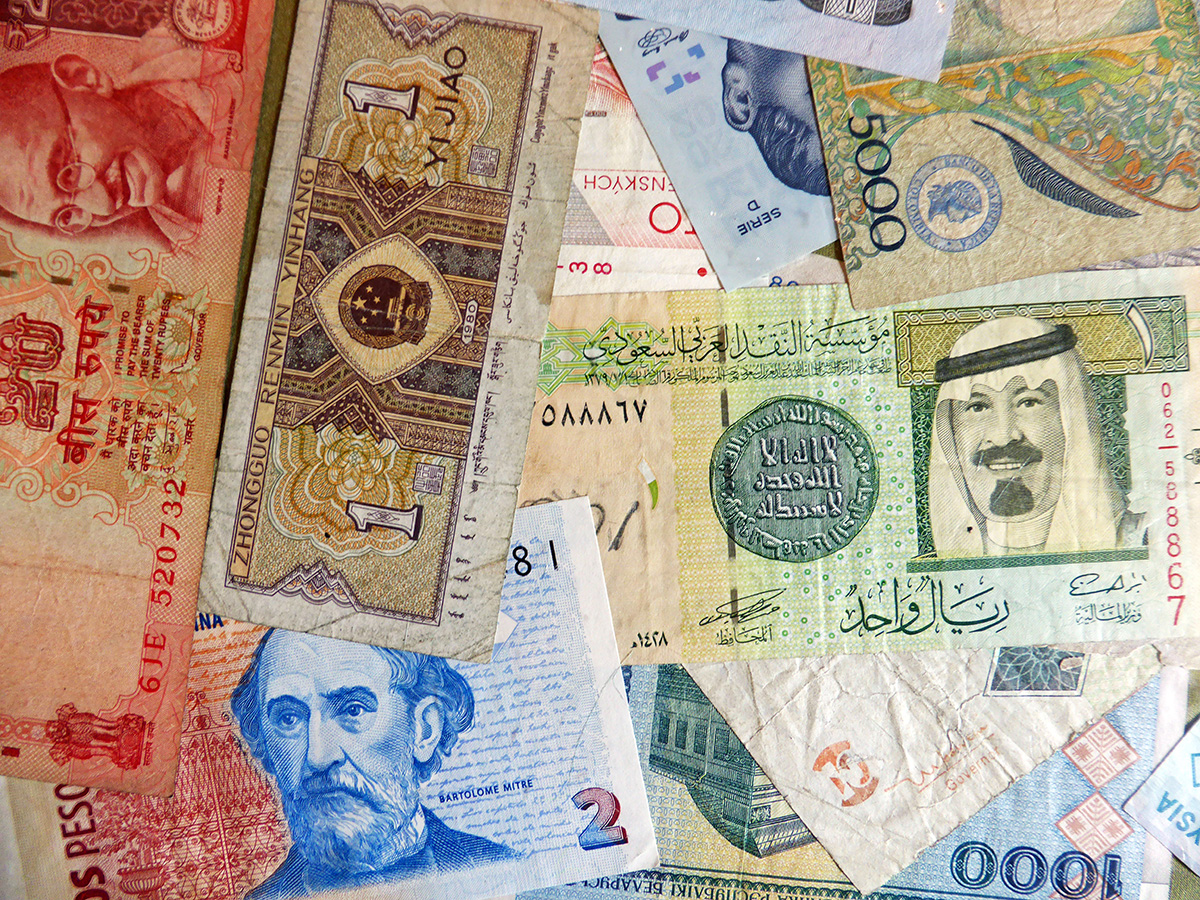 However, other monetary authorities worry that they have not yet earned the record of keeping inflation low and are concerned about the risk of wage inflation. In addition, in poorer countries there is a larger share of spending that goes on essentials such as food and energy. These have seen some of the highest price increases, so policy makers are going to be keen to stamp down on the inflation.
However, other monetary authorities worry that they have not yet earned the record of keeping inflation low and are concerned about the risk of wage inflation. In addition, in poorer countries there is a larger share of spending that goes on essentials such as food and energy. These have seen some of the highest price increases, so policy makers are going to be keen to stamp down on the inflation.
The Federal Reserve is expected to announce that it will start phasing out its $120bn monthly bond-buying programme (quantitative easing) as it confronts more pronounced price pressures and predictions that interest rates will be lifted next year. However, no adjustments are expected to be made to the Fed’s main policy rate, which is tethered near zero. Whilst financial markets are betting on an rise in Bank Rate by the Bank of England as early as next month, spurred by comments from Governor Andrew Bailey in mid-October that the central bank would ‘have to act’ to keep a lid on inflation.
Outlook for the UK
 The Bank of England’s Chief Economist, Huw Pill, has warned that high rates of inflation could last longer than expected, due to severe supply shortages and rising household energy bills. He said inflationary pressures were still likely to prove temporary and would fall back over time as the economy adjusted after disruption caused by COVID and Brexit. However, he warned there were growing risks that elevated levels of inflation could persist next year.
The Bank of England’s Chief Economist, Huw Pill, has warned that high rates of inflation could last longer than expected, due to severe supply shortages and rising household energy bills. He said inflationary pressures were still likely to prove temporary and would fall back over time as the economy adjusted after disruption caused by COVID and Brexit. However, he warned there were growing risks that elevated levels of inflation could persist next year.
The looming rise in borrowing costs for homeowners will add further pressure to family finances already stretched by higher energy bills and surging inflation. According to the Institute for Fiscal Studies, it is expected that households will face years of stagnating living standards, with predictions showing that households would on average be paying £3000 more each year in taxes by 2024/25, with the biggest impact felt by higher earners.
Investors are also reacting to concerns and have pulled $9.4bn out of UK-focused equity funds this year after hopes that a COVID-19 vaccination drive will fuel a vigorous economic recovery were overshadowed by questions about slow growth and high inflation. It is suggested that there is a general sense of caution about the UK when it comes to investing globally, driven by monetary, fiscal and trade uncertainties.
Given all the elements contributing to this outlook, The IMF has forecast that the UK will recover more slowly from the shocks of coronavirus than other G7 nations, with economic output in 2024 still 3 per cent below its pre-pandemic levels. Financial markets are predicting the Bank of England will lift interest rates as soon as the next MPC meeting. And while supply-chain bottlenecks and rising commodity prices are a global trend, the Bank’s hawkish stance has increased the possibility of a sharper slowdown in Britain than other developed markets, some analysts have said.
What next?
Some of the major central banks are poised to take centre stage when announcing their next monetary action, as it will reveal if they share the alarm about surging inflation that has gripped investors. Markets are betting that the Bank of England will begin raising interest rates, with Bank Rate expected to rise to around 1.25 per cent by the end of next year (from the current 0.1 per cent).
It is thought that the Fed will not raise interest rates just yet but will do so in the near future. Markets, businesses, and households globally will be waiting on the monetary decisions of all countries, as these decisions will shape the trajectory of the global economy over the next few years.
Articles
- Three Days Will Reveal Global Alert Level on Inflation: Eco Week
Bloomberg, Molly Smith and Craig Stirling (31/10/21)
- Inflation watch: Global food prices hit 10-year high
Al Jazeera (4/11/21)
- Fed sings the ‘transitory’ inflation refrain, unveils bond-buying ‘taper’
ReutersHoward Schneider and Ann Saphir (3/11/21)
- BoE chief economist warns UK inflation likely to hit 5%
Financial Times, Chris Giles (21/10/21)
- Inflation pressure now ‘brutal’ because of supply squeeze, US companies say
Financial Times, Andrew Edgecliffe-Johnson, Matthew Rocco, Obey Manayiti and Claire Bushey (23/10/21)
- Rising inflation could trigger global sell-off that would harm UK, says Bank
The Guardian, Richard Partington (8/10/21)
- Bank of England chief economist warns high inflation rates may persist in 2022
The Guardian, Richard Partington (7/10/21)
- Bank of England surprises markets by holding rates at record lows
CNBC, Elliot Smith (4/11/21)
 Bank of England resists pressure to raise interest rates as inflation spike looms
Bank of England resists pressure to raise interest rates as inflation spike loomsSky News, Ed Conway (4/11/21)
Forecasts and commentary
Questions
- What is the definition of inflation?
- How is inflation measured?
- Using a diagram to aid your answers, discuss the difference between cost-push and demand-pull inflation.
- What are the demand-side and cost-side causes of the current rising inflation?
- Explain the impact an increase in interest rates has on the economy.
 To make a sensible comparison of one year’s national income generated from the production of goods and services with another we need to take inflation into account. Changes in inflation-adjusted GDP represent changes in the volume of production of a country’s goods and services: in other words, the real value of goods and services. We revisit the blog written back in April 2019, prior the pandemic, to show how changes in real GDP evidence what we may refer to as the twin characteristics of economic growth: positive long-term growth but with fluctuating short-term rates of growth.
To make a sensible comparison of one year’s national income generated from the production of goods and services with another we need to take inflation into account. Changes in inflation-adjusted GDP represent changes in the volume of production of a country’s goods and services: in other words, the real value of goods and services. We revisit the blog written back in April 2019, prior the pandemic, to show how changes in real GDP evidence what we may refer to as the twin characteristics of economic growth: positive long-term growth but with fluctuating short-term rates of growth.
Real and nominal GDP
The nominal or current-price estimate for UK Gross Domestic Product in 2020 is £2.156 trillion. It is the value of output produced within the country in 2020. This was a fall of 4.4 per cent on the £2.255 trillion recorded in 2019. These values make no adjustment for inflation and therefore reflect the prices of output that were prevailing at the time.
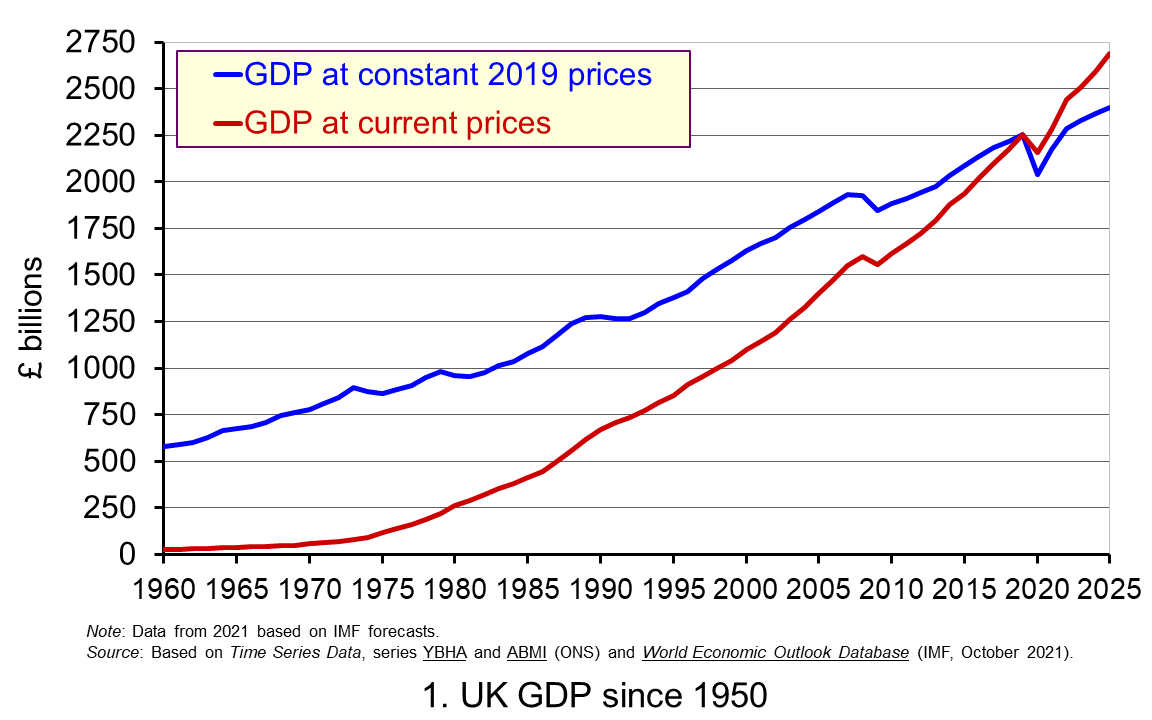 Chart 1 shows current-price estimates of GDP from 1950 when the value of GDP was estimated at £12.7 billion. The increase to £2.156 trillion in 2020 amounts to a proportionate increase of almost 170 times, a figure that rises to 211 times if we compare the 1950 value with the latest IMF estimate for 2025 of £2.689 trillion. However, if we want to make a more meaningful comparison of the country’s national income by looking at the longer-term increase in the volume of production, we need to adjust for inflation. (Click here to download a PowerPoint copy of the chart.)
Chart 1 shows current-price estimates of GDP from 1950 when the value of GDP was estimated at £12.7 billion. The increase to £2.156 trillion in 2020 amounts to a proportionate increase of almost 170 times, a figure that rises to 211 times if we compare the 1950 value with the latest IMF estimate for 2025 of £2.689 trillion. However, if we want to make a more meaningful comparison of the country’s national income by looking at the longer-term increase in the volume of production, we need to adjust for inflation. (Click here to download a PowerPoint copy of the chart.)
Long-term growth in real GDP
If we measure GDP at constant prices, we eliminate the effect of inflation. To construct a constant-price series for GDP a process known as chain-linking is used. This involves taking consecutive pairs of years, e.g. 2020 and 2021, and estimating what GDP would be in the most recent year (in this case, 2021) if the previous year’s prices (i.e. 2020) had continued to prevail. By calculating the percentage change from the previous year’s GDP value we have an estimate of the volume change. If this is repeated for other pairs of years, we have a series of percentage changes that capture the volume changes from year-to-year. Finally, a reference year is chosen and the percentage changes are applied backwards and forwards from the nominal GDP value for the reference year – the volume changes forwards and backwards from this point.
In effect, a real GDP series creates a quantity measure in monetary terms. Chart 1 shows GDP at constant 2019 prices (real GDP) alongside GDP at current prices (nominal GDP). Consider first the real GDP numbers for 1950 and 2020. GDP in 1950 at 2019 prices was £410.1 billion. This is higher than the current-price value because prices in 2019 (the reference year) were higher than those in 1950. Meanwhile, GDP in 2020 when measured at 2019 prices was £2.037 trillion. This constant-price value is smaller than the corresponding current-price value because prices in 2019 where lower than those in 2020.
Between 1950 and 2020 real GDP increased 5.0 times. If we extend the period to 2025, again using the latest IMF estimates, the increase is 5.9 times. Because we have removed the effect of inflation, the real growth figure is much lower than the nominal growth figure. Crucially, what we are left with is an indicator of the long-term growth in the volume of the economy’s output and hence an increase in national income that is backed up by an increase in production. Whereas nominal growth rates are affected both by changes in volumes and prices, real growth rates reflect only changes in volumes.
The upward trajectory observed in constant-price GDP is therefore evidence of positive longer-term growth. This is one of the twin characteristics of growth.
Short-term fluctuations in the growth of real GDP
The second characteristic is fluctuations in the rate of growth from period to period. We can see this second characteristic more clearly by plotting the percentage change in real GDP from year to year.
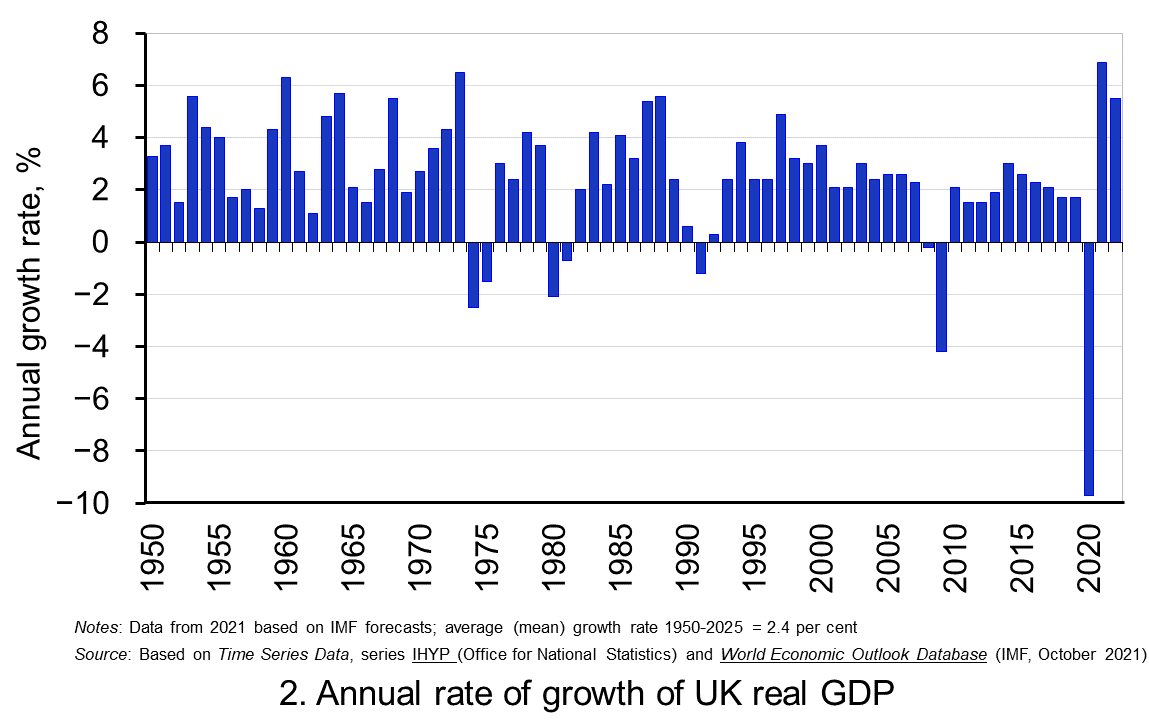 Chart 2 shows the annual rate of growth in real GDP each year since 1950. From it, we see the inherent instability that is a key characteristic of the macroeconomic environment. This instability is, of course, mirrored in the output path of real GDP in Chart 1, but the annual rates of growth show the instability more clearly. We can readily see the impact on national output of the global financial crisis and the global health emergency.
Chart 2 shows the annual rate of growth in real GDP each year since 1950. From it, we see the inherent instability that is a key characteristic of the macroeconomic environment. This instability is, of course, mirrored in the output path of real GDP in Chart 1, but the annual rates of growth show the instability more clearly. We can readily see the impact on national output of the global financial crisis and the global health emergency.
In 2009, constant-price GDP in the UK fell by 4.25 per cent. Then, in 2020, constant-price GDP and, hence, the volume of national output fell by 9.7 per cent, as compared to a 4.4 per cent fall in current-price GDP that we identified earlier. These global, ‘once-in-a-generation’ shocks are stark examples of the instability that characterises economies and which generate the ‘ups and downs’ in an economy’s output path, known more simply as ‘the business cycle’. (Click here to download a PowerPoint copy of the chart.)
Determinants of long-and short-term growth
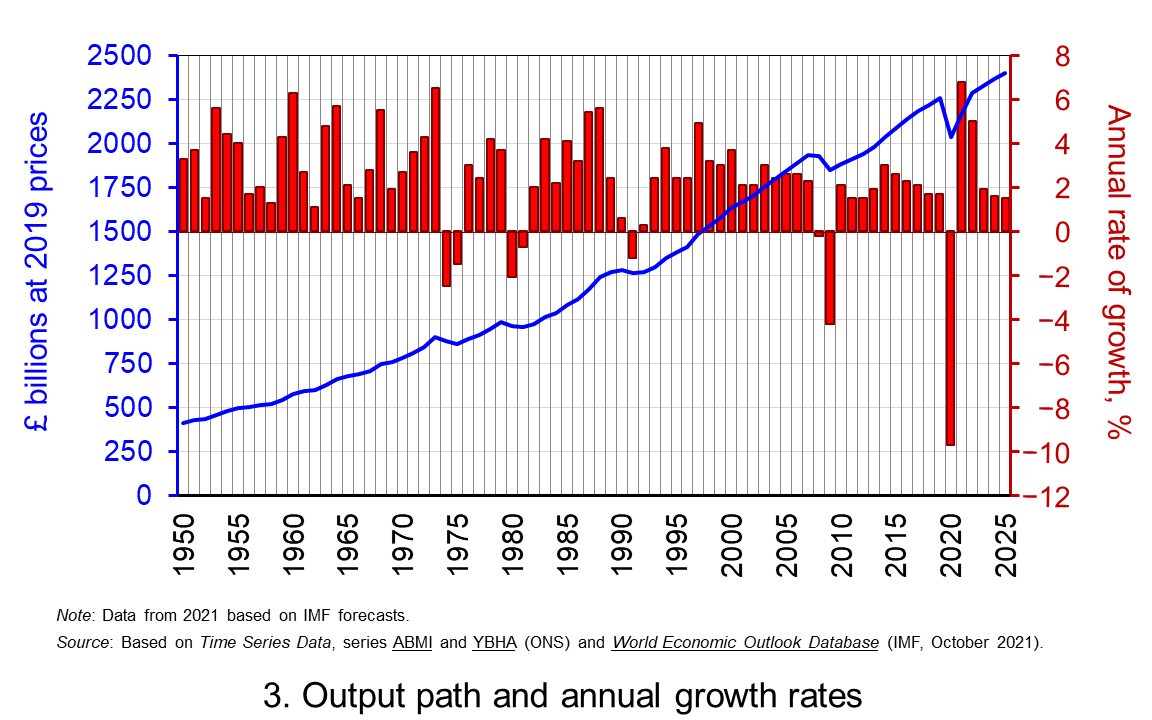 The twin characteristics of growth can be seen simultaneously by combining the output path captured by the levels of real GDP with the annual rates of growth. This is shown in Chart 3. The longer-term growth seen in the economy’s output path is generally argued to be driven by the quantity and quality of the economy’s resources, and their effectiveness when combined in production. In other words, it is the supply-side that determines the trajectory of the output path over the longer term. (Click here to download a PowerPoint copy of the chart.)
The twin characteristics of growth can be seen simultaneously by combining the output path captured by the levels of real GDP with the annual rates of growth. This is shown in Chart 3. The longer-term growth seen in the economy’s output path is generally argued to be driven by the quantity and quality of the economy’s resources, and their effectiveness when combined in production. In other words, it is the supply-side that determines the trajectory of the output path over the longer term. (Click here to download a PowerPoint copy of the chart.)
However, the fluctuations we observe in short-term growth rates tend to reflect impulses that affect the ability and or willingness of producers to supply (supply-side shocks) and purchasers to consume (demand-side shocks). These impulses are then propagated and their effects, therefore, transmitted through the economy.
Effects of the pandemic
The pandemic is unusual in that the health intervention measures employed by governments around the world resulted in simultaneous negative aggregate demand and aggregate supply shocks. Economists were particularly concerned that the magnitude of these impulses and their propagation had the potential to generate scarring effects and hence negative hysteresis effects. The concern was that these would affect the level of real GDP in the medium-to-longer term and, hence, the vertical position of the output path, as well as the longer-term rate of growth and, hence, the steepness of the output path.
The extent of these scarring effects continues to be debated. The ability of businesses and workers to adapt their practices, the extraordinary fiscal and monetary measures that were undertaken in many countries, and the roll-out of vaccines programmes, especially in advanced economies, have helped to mitigate some of these effects. For example, the latest IMF forecasts for output in the USA in 2024 are over 2 per cent higher than those made back in October 2019.
Scarring effects are, however, thought to be an ongoing issue in the UK. The IMF is now expecting output in the UK to be nearly 3 per cent lower than it originally forecast back in October 2019. Therefore, whilst UK output is set to recover, scarring effects on the UK economy will mean that the output path traced out by real GDP will remain, at least in the medium term, vertically lower than was expected before the pandemic.
Data and Reports
Articles
Questions
- What do you understand by the term ‘macroeconomic environment’? What data could be used to describe the macroeconomic environment?
- When a country experiences positive rates of inflation, which is higher: nominal economic growth or real economic growth?
- Does an increase in nominal GDP mean a country’s production has increased? Explain your answer.
- Does a decrease in nominal GDP mean a country’s production has decreased? Explain your answer.
- Why does a change in the growth of real GDP allow us to focus on what has happened to the volume of production?
- What does the concept of the ‘business cycle’ have to do with real rates of economic growth?
- When would falls in real GDP be classified as a recession?
- Distinguish between the concepts of ‘short-term growth rates’ and ‘longer-term growth’.
- What do you understand by the term hysteresis? By what means can hysteresis effects be generated?
- Discuss the proposition that the pandemic could have a positive effect on longer-term growth rates because of the ways that people and business have had to adapt.
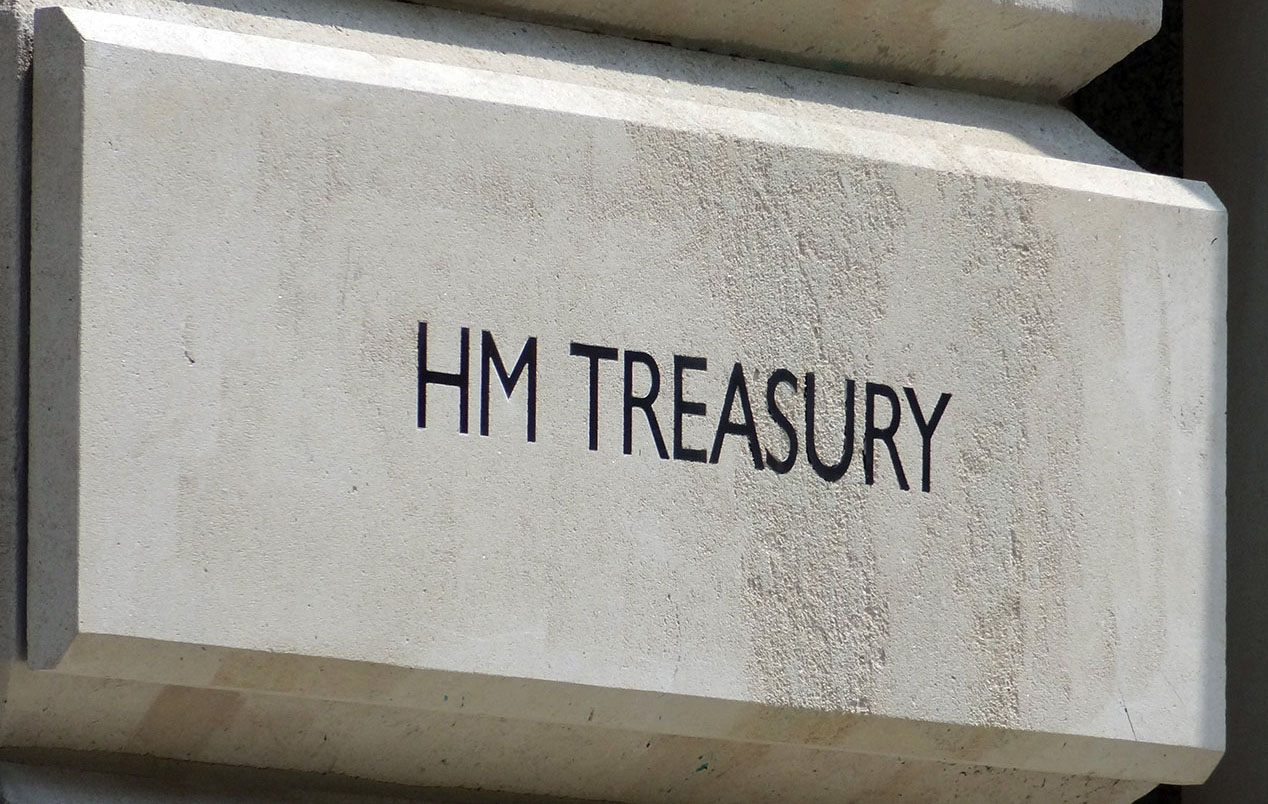 The COVID-19 pandemic had a stark effect on countries’ public finances. Governments had to make difficult fiscal choices around spending and taxation to safeguard public health, and the protection of jobs and incomes both in the present and in the future. The fiscal choices were to have historically large effects on the size of public spending and on the size of public borrowing.
The COVID-19 pandemic had a stark effect on countries’ public finances. Governments had to make difficult fiscal choices around spending and taxation to safeguard public health, and the protection of jobs and incomes both in the present and in the future. The fiscal choices were to have historically large effects on the size of public spending and on the size of public borrowing.
Here we briefly summarise the magnitude of these effects on public spending, receipts and borrowing in the UK.
The public sector comprises both national government and local or regional government. In financial year 2019/20 public spending in the UK was £886 billion. This would rise to £1.045 trillion in 2020/21. To understand better the magnitude of these figures we can express them as a share of national income (Gross Domestic Product). In 2019/20 public spending was 39.8 per cent of national income. This rose to 52.1 per cent in 2020/21. Meanwhile, public-sector receipts, largely taxation, fell from £829.1 billion in 2019/20 to £796.5 billion in 2020/21, though, because of the fall in national income, the share of receipts in national income rose very slightly from 37.3 to 37.9 per cent of national income.
The chart shows both public spending and public receipts as a share of national income since 1900. (Click here for a PowerPoint of the chart.) What this chart shows is the extraordinary impact of the two World Wars on the relative size of public spending. We can also see an uptick in public spending following the global financial crisis and, of course, the COVID-19 pandemic. The chart also shows that spending is typically larger than receipts meaning that the public sector typically runs a budget deficit. 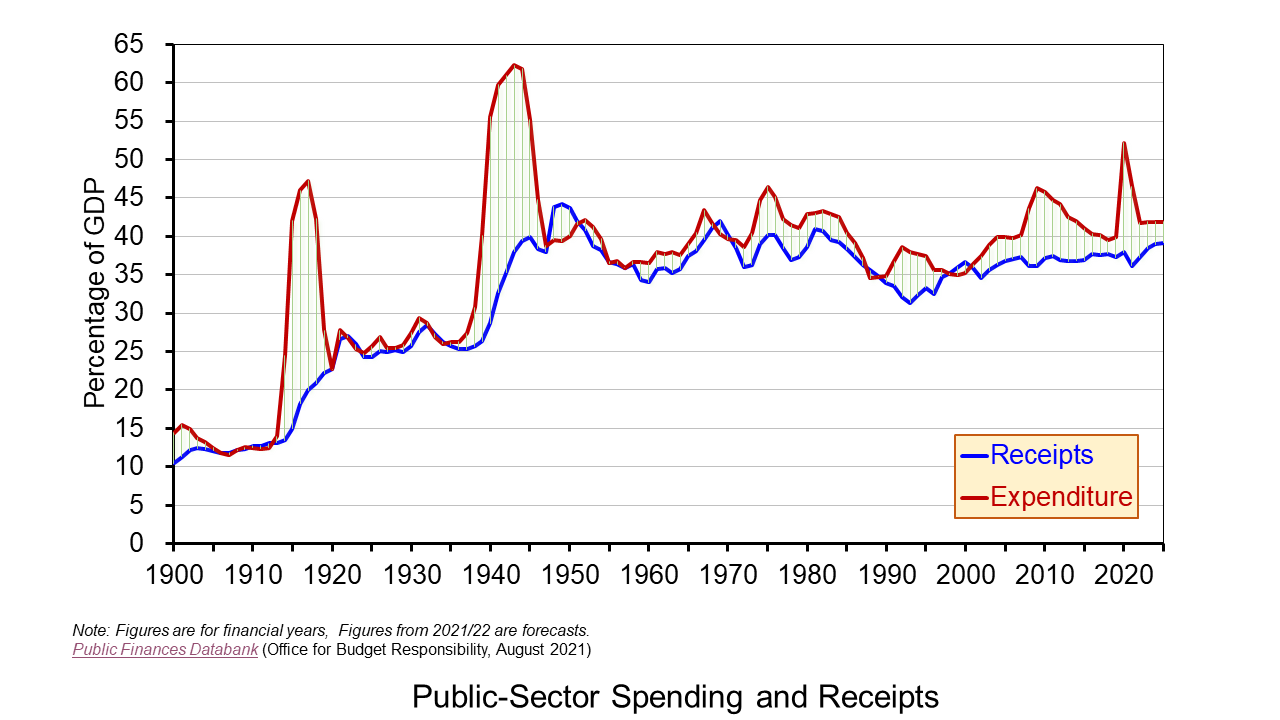 .
.
If we focus on public spending as a share of national income and its level following the two world wars, we can see that it did not fall back to pre-war levels. This is what Peacock and Wiseman (1961) famously referred to as a displacement effect. They attributed this to, among other things, an increase in the public’s tolerance to pay higher taxation because of the higher taxes levied during the war as well as to a desire for greater public intervention. The latter arose from an inspection effect. This can be thought of as a public consciousness effect, with the war helping to shine a light on a range of economic and social issues, such as health, housing and social security. These two effects, it is argued, reinforced each other, allowing the burden of taxation to rise and, hence, public spending to increase relative to national income.
If we forward to the global financial crisis, we can again see public spending rise as a share of national income. However, this time the ratio did not remain above pre-crisis levels. Rather, the UK government was fearful of unsustainable borrowing levels and the crowding out of private-sector activity by the public sector, with higher interest rates making public debt an attractive proposition for investors. It thus sought to reduce the public-sector deficit by engaging in what became known as ‘austerity’ measures.
 If we move forward further to the COVID-19 pandemic, we see an even more significant spike in public spending as a share of national income. It is of course rather early to make predictions about whether the pandemic will have enduring effects on public spending and taxation. Nonetheless the pandemic, in a similar way to the two world wars, has sparked public debates on many economic and social issues. Whilst debates around the funding of health and social care are longstanding, it could be argued that the pandemic has provided the government with the opportunity to introduce the 1.25 percentage point levy from April 2022 on the earned incomes of workers (both employees and the self-employed) and on employers. (See John’s blog Fair care? for a fuller discussion on the tax changes to pay for increased health and social care expenditure).
If we move forward further to the COVID-19 pandemic, we see an even more significant spike in public spending as a share of national income. It is of course rather early to make predictions about whether the pandemic will have enduring effects on public spending and taxation. Nonetheless the pandemic, in a similar way to the two world wars, has sparked public debates on many economic and social issues. Whilst debates around the funding of health and social care are longstanding, it could be argued that the pandemic has provided the government with the opportunity to introduce the 1.25 percentage point levy from April 2022 on the earned incomes of workers (both employees and the self-employed) and on employers. (See John’s blog Fair care? for a fuller discussion on the tax changes to pay for increased health and social care expenditure).
The extent to which there may be a pandemic displacement effect will depend on the fiscal choices made in the months and years ahead. The key question is how powerful will be the effect of social issues like income and wealth inequality, regional and inter-generational disparities, discrimination, poor infrastructure and educational opportunities in shaping these fiscal choices? Will these considerations carry more weight than the push to consolidate the public finances and tighten the public purse? These fiscal choices will determine the extent of any displacement effect in public spending and taxation.
Reference
Alan Peacock and Jack Wiseman, The Growth in Public Expenditure in the United Kingdom, Princeton University Press (1961).
Articles
Questions
- What do you understand by the term ‘public finances’?
- Why might you wish to express the size of public spending relative to national income rather than simply as an absolute amount?
- Undertake research to identify key pieces of social policy in the UK that were enacted at or around the times of the two World Wars.
- What do you understand by the terms ‘tolerable tax burden’ and ‘inspection effect’?
- Identify those social issues that you think have come into the spotlight as a result of the pandemic. Undertake research on any one of these and write a briefing note exploring the issue and the possible policy choices available to government.
- What is the concept of crowding out? How might it affect fiscal choices?
- How would you explain the distinction between public-sector borrowing and public-sector debt? Why could the former fall and the latter rise at the same time?
 In March 2020, the UK government introduced a Coronavirus Job Retention Scheme. Businesses that had to close or cut back could put staff on furlough and the scheme would allow employers to claim 80% of workers’ wages up to £2500 per month. This would be passed on to workers.
In March 2020, the UK government introduced a Coronavirus Job Retention Scheme. Businesses that had to close or cut back could put staff on furlough and the scheme would allow employers to claim 80% of workers’ wages up to £2500 per month. This would be passed on to workers.
There was large-scale uptake of the scheme. By the end of August, 9.6 million employees were on furlough (28% of the workforce) from around 1.2 million employers (61% of eligible employers). The scheme significantly stemmed the rise in unemployment. The claimant count rose 121% from March to August from 1.24 million to 2.74 million, far less than it would have done without the furlough scheme.
Since 1 August the level of support has been reduced in stages and is due to end on 31 October. It will then be replaced by a new ‘Job Support Scheme (JSS)‘ running from 1 November 2020 to 30 April 2021. Initially, employees must work at least 33% of their usual hours. For hours not worked, the government and the employer will pay a third each. There would be no pay for the final third. This means that an employee would receive at least 77.7% (33% + (2/3)67%) of their full pay – not far short of the 80% under the furlough scheme.
Effects on unemployment
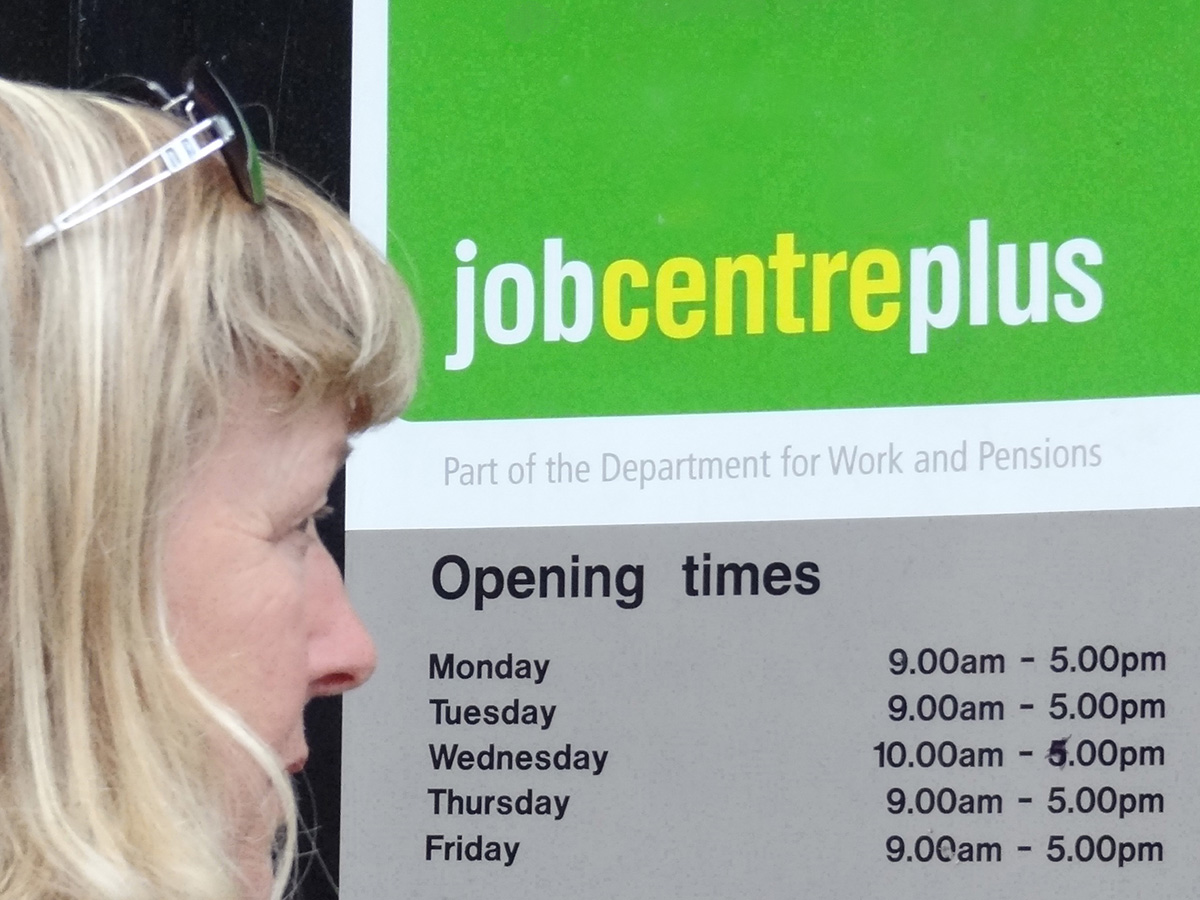 Will the scheme see a substantial rise in unemployment, or will it be enough to support a gradual recovery in the economy as more businesses are able to reopen or take on more staff?
Will the scheme see a substantial rise in unemployment, or will it be enough to support a gradual recovery in the economy as more businesses are able to reopen or take on more staff?
On first sight, it might seem that the scheme will give only slightly less job protection than the job furlough scheme with employees receiving only a little less than before. But, unlike the previous scheme, employers will have to pay not only for work done, but also an additional one-third for work not done. This is likely to encourage employers to lay off part of their staff and employ the remainder for more than one-third of their usual hours. Other firms may simply not engage with the scheme.
What is more, the furlough scheme paid wages for those previously employed by firms that were now closed. Under the new scheme, employees of firms that are forced to stay closed, such as many in the entertainments industry, will receive nothing. They will lose their jobs (at least until such firms are able to reopen) and will thus probably have to look for a new job. The scheme does not support them.
The government acknowledges that some people will lose their jobs but argues that it should not support jobs that are no longer viable. The question here is whether some jobs will eventually become viable again when the Covid restrictions are lifted.
With Covid cases on the rise again and more restrictions being imposed, especially at a local level, it seems inevitable that unemployment will continue to rise for some time with the ending of the furlough scheme and as the demand for labour remains subdued. The ending of the new scheme in April could compound the problem. Even when unemployment does begin to fall, it may take many months to return to pre-pandemic levels.
Update: expansion of the scheme
On 9 October, with Covid-19 cases rising rapidly in some parts of the country and tighter restrictions being imposed, the government announced that it was extending the scheme. From 1 November, employees of firms in certain parts of the country that would be required to close by the government, such as bars and restaurants, would be paid two-thirds of their previous wages by the government.
Critics of this extension to the scheme argue many firms will still be forced to shut because of lack of demand, even though they are not legally being required close. Employees of such firms will receive nothing from the scheme and will be forced onto Universal Credit. Also, the scheme will mean that many of the workers who do receive the money from the government will still face considerable hardship. Many will previously have been on minimum wages and thus will struggle to manage on only two-thirds of their previous wages.
Articles
- Job Support Scheme: What will I be paid after furlough?
BBC News, Eleanor Lawrie (1/10/20)
- Chancellor unveils new Job Support Scheme and extends self-employed grant
MSE News, Callum Mason (24/9/20)
- Sunak has bought himself time, but his big test will come as crisis eases
IFS Newspaper article, Paul Johnson (28/9/20)
 The businesses that feel left behind by Sunak’s jobs support scheme
The businesses that feel left behind by Sunak’s jobs support schemeChannel 4 News, Paul McNamara (25/9/20
- Covid: Jobs scheme ‘won’t stop major rise in unemployment’
BBC News (25/9/20)
- How the new Job Support Scheme will work
FT Adviser, Richard Churchill (30/9/20)
- Covid scheme: UK government to cover 22% of worker pay for six months
The Guardian, Phillip Inman (24/9/20)
- Hard winter ahead as Sunak tries to stop job losses hitting postwar record
The Guardian, Larry Elliott (24/9/20)
- Job Support Scheme ‘won’t reduce job losses’
Personnel Today, Ashleigh Webber (25/9/20)
- Sunak’s new job support scheme offers warm words but no escape from the coming unemployment chill
The Conversation, David Spencer (24/9/20)
Articles: update
Government information
Questions
- If people on furlough were counted as unemployed, find out what would have happened to the unemployment rate between March and August 2020.
- If an employer were previously employing two people doing the same type of job and now has enough work for only one person, under the Job Support Scheme would it be in the employers’ financial interest to employ one worker full time and make the other redundant or employ both of the workers half time? Explain your arguments.
- What are the arguments for and against the government supporting jobs for more than a few months?
- What determines the mobility of labour? What policies could the government pursue to increase labour mobility?
- Find out what policies to support employment or wages have been pursued by two other countries since the start of the pandemic. Compare them with the policies of the UK government.
 In a little over a decade economies around the world have experienced two ‘once-in-a-lifetime’ shocks. First, there was the global financial crisis of the late 2000s, which saw an unsustainable expansion of banks’ balance sheets that resulted in a global economic slowdown. Now in 2020, a global health emergency has meant unprecedented falls in economic activity. In both cases, the public sector has been the economy’s shock absorber but this has had dramatic effects on its financial wellbeing. We consider here the effect on the UK public finances and reflect on their sustainability in light of the recent Fiscal Sustainability Report published by the Office of Budget Responsibility (OBR).
In a little over a decade economies around the world have experienced two ‘once-in-a-lifetime’ shocks. First, there was the global financial crisis of the late 2000s, which saw an unsustainable expansion of banks’ balance sheets that resulted in a global economic slowdown. Now in 2020, a global health emergency has meant unprecedented falls in economic activity. In both cases, the public sector has been the economy’s shock absorber but this has had dramatic effects on its financial wellbeing. We consider here the effect on the UK public finances and reflect on their sustainability in light of the recent Fiscal Sustainability Report published by the Office of Budget Responsibility (OBR).
The COVID-19 pandemic saw the government initiate a range of fiscal interventions to support people and businesses. Interventions directly affecting public-sector spending included a series of employment support measures. These included the Coronavirus Job Retention Scheme, commonly referred to as the furlough scheme, the Self-employed Income Support scheme, a ‘Kickstart Scheme’ of work placements for universal credit recipients aged between 16 and 24 and a ‘Job Retention Bonus’ whereby employers can receive a one-off payment of £1,000 for every furloughed employee continuously employed from the cessation of the Job Retention Scheme on 31 October through to 31 January 2021.
Further spending interventions have included small business grant schemes, such as the Coronavirus Small Business Grant Fund, the coronavirus Retail, Hospitality and Leisure Grant Fund and the Coronavirus Local Authority Discretionary Grants Fund.
Meanwhile, taxation relief measures have included a business rates holiday for retail, hospitality and leisure businesses and a reduced rate of VAT of 5 per cent for hospitality, accommodation and attractions until 12 January 2021.
OBR’s central scenario
The OBR in its Fiscal Stability Report in July 2020 attempts to assess the wellbeing of the public finances not just in the short term but in the medium and longer term too. This longer-term perspective allows it to assess the sustainability of the public finances.
 Its analysis is based on some key assumptions, including population growth and future demands on public services, but, understandably, the timing of this report has necessitated some key assumptions around path of the economy, including the extent to which the economy will experience scarring effects, also known as hysteresis effects. While the analysis does not incorporate the Chancellor’s measures announced in its summer statement on the 8 July, including the kickstart scheme, job retention bonus and the reduced rate of VAT, which would have a material effect on this year’s numbers, the OBR concludes that there would be less significant impact on its medium-term analysis.
Its analysis is based on some key assumptions, including population growth and future demands on public services, but, understandably, the timing of this report has necessitated some key assumptions around path of the economy, including the extent to which the economy will experience scarring effects, also known as hysteresis effects. While the analysis does not incorporate the Chancellor’s measures announced in its summer statement on the 8 July, including the kickstart scheme, job retention bonus and the reduced rate of VAT, which would have a material effect on this year’s numbers, the OBR concludes that there would be less significant impact on its medium-term analysis.
In what it describes as its ‘central scenario’ the OBR forecasts that national output (real GDP) will fall by 12 per cent in 2020 before growing by 9 per cent in 2021 and 4 per cent in 2022. National output therefore reaches its pre-virus peak at the end of 2022. However, 20 quarters on from the pandemic shock in Q1 2020 output is estimated to be 3.2 per cent less than it would otherwise have been, while the cumulative loss of output is expected to be 6.4 per cent over the period. The cumulative loss of output in the 20 quarters following the financial crisis (Q2 2008) is estimated to have been 9.3 per cent of actual cumulative output.
While national output is expected to be permanently lower because of the pandemic, consistent with hysteresis, the forecast assumes that the longer-term growth rate is unaffected. In other words, there is not expected to be what some now refer to as ‘super hysteresis’, whereby the scarring effects have persistent effects on rates of capital accumulation, innovation and productivity, which therefore depress structural economic growth rates.
Meanwhile, the unemployment rate is expected to peak at 11.9 per cent in the final quarter of this year, before falling to 8.8 per cent in Q4 2021 and 6.3 per cent in Q4 2022. By Q4 2025 the unemployment rate is forecast to be 5.1 per cent, one percentage point higher than the OBR was forecasting at the time of the Budget in March.
Spending and receipts
Chart 1 shows shows the predicted paths of (nominal) public-sector receipts and expenditures as a percentage of (nominal) GDP. Receipts are expected come in at £740 billion this financial year (excluding the impact of the summer statement measures), some £133 billion lower than was forecast at the time of the March budget. This will amount to a 10 per cent fall in receipts in the financial year, driven by a much-shrunken economy. However, the fact that nominal GDP falls somewhat more means that the receipts-to-GDP ratio ticks up slightly. (Click here for a PowerPoint of the chart.)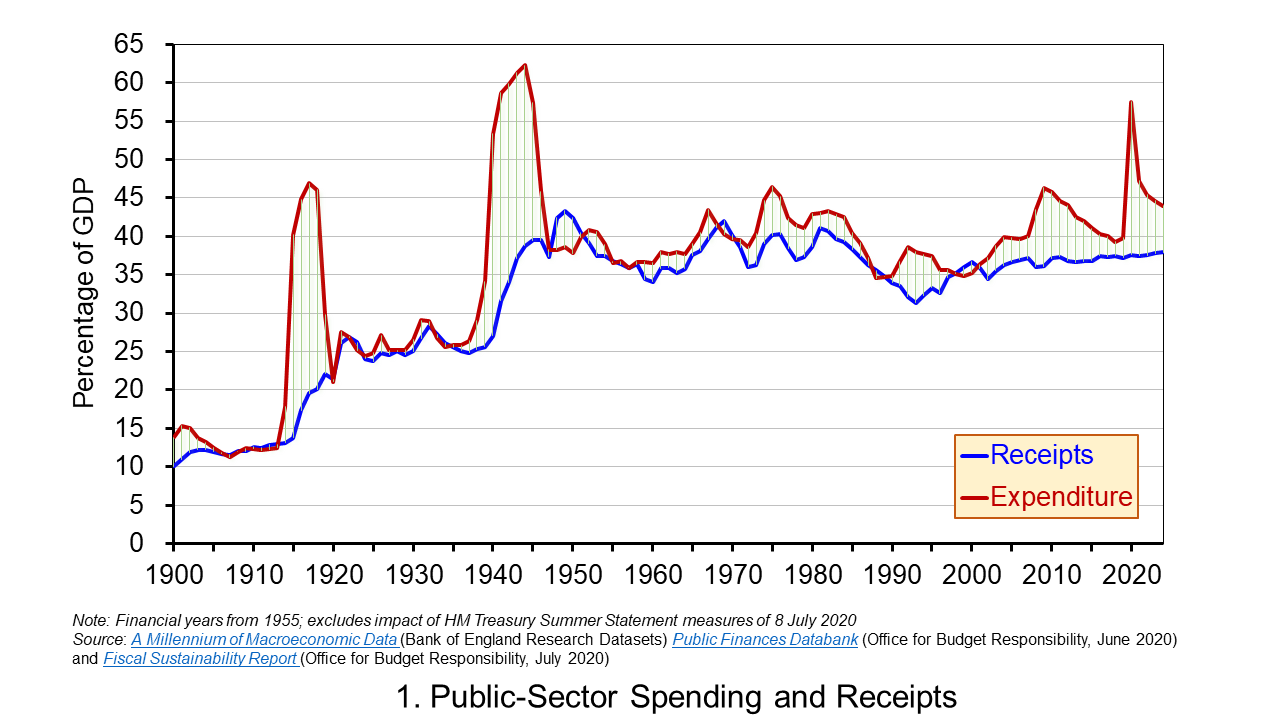
Public-sector spending is expected to be higher in 2020/21 than was forecast in the March by £135 million (excluding the summer statement measures) reflecting the COVID-19 interventions. This would result in spending rising to £1.06 trillion, a 20 per cent rise in the financial year. It would also mean that public-sector spending as a share of GDP rises to 54 per cent – its highest since 1945/46.
Going forward, in cash terms receipts are permanently lower than forecast because GDP is lower, though as a share of GDP cash receipts increase very slightly, but remain below what was expected at the time of the March budget. Spending in cash terms is expected to fall back by close to 8 per cent next financial year before increasing by 3 per cent per year up to 2024/25. This means that the spending-to-GDP ratio falls back to around 43 per cent by 2024/25, a couple of percentage points higher than was forecast back in March.
Deficits and debt
The difference between spending and receipts is known as public-sector net borrowing. While the extent of borrowing can be inferred by inspection of Chart 1, it can be seen more readily in Chart 2 which plots the path of public-sector net borrowing as a share of GDP.
The OBR is now forecasting a budget deficit of £322 billion (excluding the summer statement measures) in 2020/21 compared to £55 billion at the time of the March Budget. This would be equivalent to over 16 per cent of GDP, the highest since the Second World War. In a follow-up presentation on the Fiscal Stability Report on the 14 July the OBR suggested that the inclusion of summer statement measures could mean the deficit being as high as £375 billion, implying a deficit-to-GDP ratio of just shy of 19 per cent. (Click here for a PowerPoint of the chart.)
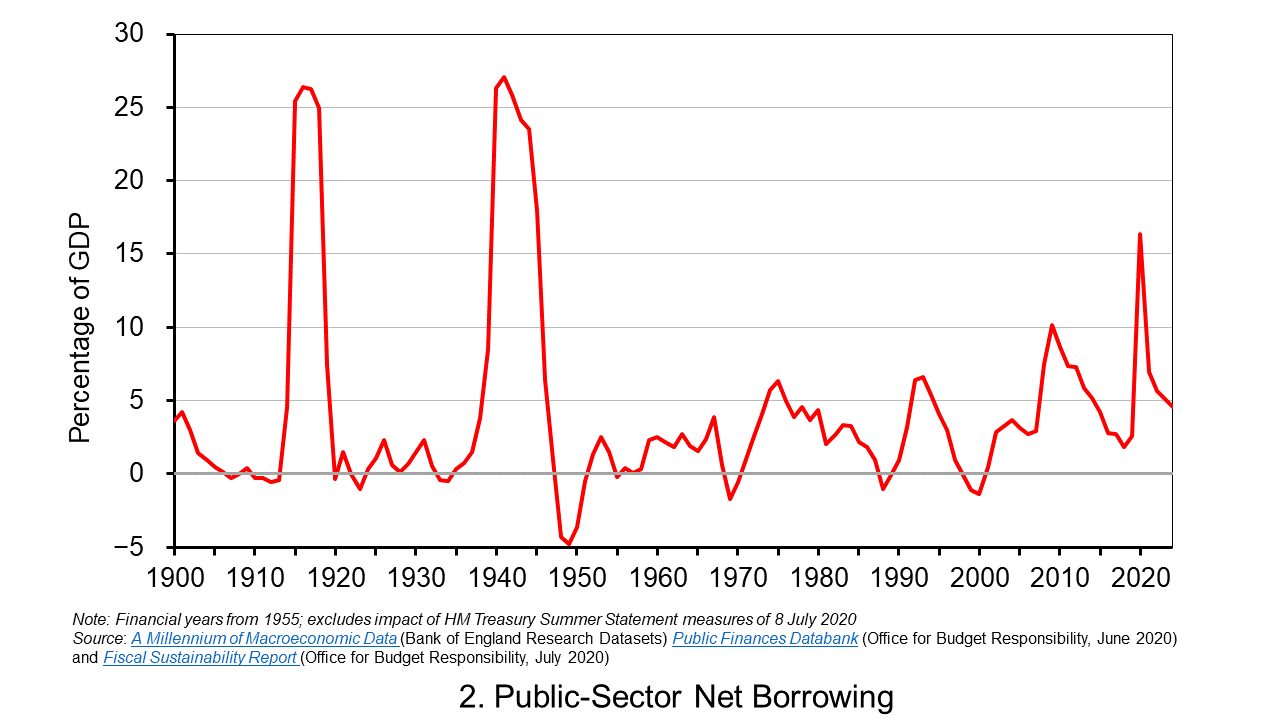
Deficits represent borrowing and are therefore a flow concept. The accumulated deficits over the years (minus any surpluses) gives total debt, which is a stock concept. The public-sector’s net debt is its gross debt less its liquid assets, principally deposits held with financial institutions and holdings of international reserves. This is also affected by Bank of England interventions, such as the Term Funding Scheme which enables banks and building societies to borrow funds at close to Bank Rate for up to four years. Nonetheless, the key driver of net debt-to-GDP ratio going forward is the persistence of deficits.
Chart 3 shows the expected path of the net debt-to-GDP ratio. The OBR expects this to exceed 100 per cent in 2020/21 for the first time since 1960/61. This reflects an increase in cash terms of the stock of net debt to £2.2 trillion, up from £1.8 trillion at the end of 2019/20, as well as a fall in GDP. By 2024/25 the net debt stock is expected to have risen to £2.6 trillion, £600 billion more than expected at the time of the March budget, with the net debt-to-GDP ratio still above 100 per cent at 102.1 per cent. (Click herefor a PowerPoint of the chart.)

Sustainability
The higher debt-to-GDP ratio raises longer-term questions about the sustainability of the public finances. The government is currently reviewing its fiscal rules and is expected to report back in time for the autumn budget. A key question is what debt-stabilising level might be considered appropriate. Is it the 102 per cent that the OBR is predicting at the end of 2024/25 (the medium-term horizon)? Or is it the 75 per cent that was being forecast for this point back in the March budget? This has profound implications for the fiscal arithmetic and, specifically, for the primary balance (the difference between non-interest spending and receipts) that the public sector needs to run.
If the government accepts a higher debt-to-GDP ratio as a ‘new norm’ that eases the fiscal arithmetic somewhat. However, some economists would be concerned about the economic consequences of larger public-sector debts, most notably so-called potential crowding-out effects on private-sector investment if upward pressure on interest rates was to materialise (see the news item MMT – a Magic Money Tree or Modern Monetary Theory?).
Even if the higher stabilising debt level was deemed appropriate, the OBR’s report analysis suggests problems in the government meeting this because it could still be running a primary deficit of 3.7 per cent of GDP by 2024/25. Therefore, even with interest rates expected to be lower than economic growth rates in 2024/25 (a negative growth-corrected interest rate) that enable governments to run primary deficits and yet maintain debt-to-GDP ratios, the debt-stabilising primary deficit for 2024/25 is estimated at only 3.2 per cent. All in all, this points to difficult fiscal choices ahead.
Articles
Questions
- What do you understand by the term financial wellbeing? What might this mean in respect of the government?
- What is meant by the fiscal arithmetic of government debt? Explain the factors that determine the fiscal arithmetic and the path of government debt?
- What is the difference between an increase in the size of a government deficit and an increase in the stock of government debt?
- Discuss the economic argument that, following the COVID-19 pandemic, government should avoid a return to an agenda of fiscal austerity ?
- What is the difference between the budget deficit, the primary deficit and the structural deficit?
- What are hysteresis effects? Discuss their relevancy in the design of the UK’s COVID-19 interventions.
 Inflation has surged worldwide as countries have come out of their COVID-19 lockdowns. The increases in prices combined with supply-chain problems has raised questions of what will happen to future prices and whether it will feed further inflation cycles.
Inflation has surged worldwide as countries have come out of their COVID-19 lockdowns. The increases in prices combined with supply-chain problems has raised questions of what will happen to future prices and whether it will feed further inflation cycles. Globally, rising inflation is causing concern as a surge in demand has been confronted by supply bottlenecks and rising prices of energy and raw materials. As the world emerges from the COVID-19 lockdowns, global financial markets have been affected in recent months by concerns around inflation. They have also been affected by the prospect of major central banks around the world being forced into the early removal of pandemic support measures, such as quantitative easing, before the economic recovery from the coronavirus is complete.
Globally, rising inflation is causing concern as a surge in demand has been confronted by supply bottlenecks and rising prices of energy and raw materials. As the world emerges from the COVID-19 lockdowns, global financial markets have been affected in recent months by concerns around inflation. They have also been affected by the prospect of major central banks around the world being forced into the early removal of pandemic support measures, such as quantitative easing, before the economic recovery from the coronavirus is complete. However, other monetary authorities worry that they have not yet earned the record of keeping inflation low and are concerned about the risk of wage inflation. In addition, in poorer countries there is a larger share of spending that goes on essentials such as food and energy. These have seen some of the highest price increases, so policy makers are going to be keen to stamp down on the inflation.
However, other monetary authorities worry that they have not yet earned the record of keeping inflation low and are concerned about the risk of wage inflation. In addition, in poorer countries there is a larger share of spending that goes on essentials such as food and energy. These have seen some of the highest price increases, so policy makers are going to be keen to stamp down on the inflation. The Bank of England’s Chief Economist, Huw Pill, has warned that high rates of inflation could last longer than expected, due to severe supply shortages and rising household energy bills. He said inflationary pressures were still likely to prove temporary and would fall back over time as the economy adjusted after disruption caused by COVID and Brexit. However, he warned there were growing risks that elevated levels of inflation could persist next year.
The Bank of England’s Chief Economist, Huw Pill, has warned that high rates of inflation could last longer than expected, due to severe supply shortages and rising household energy bills. He said inflationary pressures were still likely to prove temporary and would fall back over time as the economy adjusted after disruption caused by COVID and Brexit. However, he warned there were growing risks that elevated levels of inflation could persist next year. Bank of England resists pressure to raise interest rates as inflation spike looms
Bank of England resists pressure to raise interest rates as inflation spike looms To make a sensible comparison of one year’s national income generated from the production of goods and services with another we need to take inflation into account. Changes in inflation-adjusted GDP represent changes in the volume of production of a country’s goods and services: in other words, the real value of goods and services. We revisit the
To make a sensible comparison of one year’s national income generated from the production of goods and services with another we need to take inflation into account. Changes in inflation-adjusted GDP represent changes in the volume of production of a country’s goods and services: in other words, the real value of goods and services. We revisit the  Chart 1 shows current-price estimates of GDP from 1950 when the value of GDP was estimated at £12.7 billion. The increase to £2.156 trillion in 2020 amounts to a proportionate increase of almost 170 times, a figure that rises to 211 times if we compare the 1950 value with the latest IMF estimate for 2025 of £2.689 trillion. However, if we want to make a more meaningful comparison of the country’s national income by looking at the longer-term increase in the volume of production, we need to adjust for inflation. (Click
Chart 1 shows current-price estimates of GDP from 1950 when the value of GDP was estimated at £12.7 billion. The increase to £2.156 trillion in 2020 amounts to a proportionate increase of almost 170 times, a figure that rises to 211 times if we compare the 1950 value with the latest IMF estimate for 2025 of £2.689 trillion. However, if we want to make a more meaningful comparison of the country’s national income by looking at the longer-term increase in the volume of production, we need to adjust for inflation. (Click  Chart 2 shows the annual rate of growth in real GDP each year since 1950. From it, we see the inherent instability that is a key characteristic of the macroeconomic environment. This instability is, of course, mirrored in the output path of real GDP in Chart 1, but the annual rates of growth show the instability more clearly. We can readily see the impact on national output of the global financial crisis and the global health emergency.
Chart 2 shows the annual rate of growth in real GDP each year since 1950. From it, we see the inherent instability that is a key characteristic of the macroeconomic environment. This instability is, of course, mirrored in the output path of real GDP in Chart 1, but the annual rates of growth show the instability more clearly. We can readily see the impact on national output of the global financial crisis and the global health emergency. The twin characteristics of growth can be seen simultaneously by combining the output path captured by the levels of real GDP with the annual rates of growth. This is shown in Chart 3. The longer-term growth seen in the economy’s output path is generally argued to be driven by the quantity and quality of the economy’s resources, and their effectiveness when combined in production. In other words, it is the supply-side that determines the trajectory of the output path over the longer term. (Click
The twin characteristics of growth can be seen simultaneously by combining the output path captured by the levels of real GDP with the annual rates of growth. This is shown in Chart 3. The longer-term growth seen in the economy’s output path is generally argued to be driven by the quantity and quality of the economy’s resources, and their effectiveness when combined in production. In other words, it is the supply-side that determines the trajectory of the output path over the longer term. (Click  The COVID-19 pandemic had a stark effect on countries’ public finances. Governments had to make difficult fiscal choices around spending and taxation to safeguard public health, and the protection of jobs and incomes both in the present and in the future. The fiscal choices were to have historically large effects on the size of public spending and on the size of public borrowing.
The COVID-19 pandemic had a stark effect on countries’ public finances. Governments had to make difficult fiscal choices around spending and taxation to safeguard public health, and the protection of jobs and incomes both in the present and in the future. The fiscal choices were to have historically large effects on the size of public spending and on the size of public borrowing. .
. If we move forward further to the COVID-19 pandemic, we see an even more significant spike in public spending as a share of national income. It is of course rather early to make predictions about whether the pandemic will have enduring effects on public spending and taxation. Nonetheless the pandemic, in a similar way to the two world wars, has sparked public debates on many economic and social issues. Whilst debates around the funding of health and social care are longstanding, it could be argued that the pandemic has provided the government with the opportunity to introduce the 1.25 percentage point levy from April 2022 on the earned incomes of workers (both employees and the self-employed) and on employers. (See John’s blog
If we move forward further to the COVID-19 pandemic, we see an even more significant spike in public spending as a share of national income. It is of course rather early to make predictions about whether the pandemic will have enduring effects on public spending and taxation. Nonetheless the pandemic, in a similar way to the two world wars, has sparked public debates on many economic and social issues. Whilst debates around the funding of health and social care are longstanding, it could be argued that the pandemic has provided the government with the opportunity to introduce the 1.25 percentage point levy from April 2022 on the earned incomes of workers (both employees and the self-employed) and on employers. (See John’s blog  In March 2020, the UK government introduced a
In March 2020, the UK government introduced a  Will the scheme see a substantial rise in unemployment, or will it be enough to support a gradual recovery in the economy as more businesses are able to reopen or take on more staff?
Will the scheme see a substantial rise in unemployment, or will it be enough to support a gradual recovery in the economy as more businesses are able to reopen or take on more staff?  In a little over a decade economies around the world have experienced two ‘once-in-a-lifetime’ shocks. First, there was the global financial crisis of the late 2000s, which saw an unsustainable expansion of banks’ balance sheets that resulted in a global economic slowdown. Now in 2020, a global health emergency has meant unprecedented falls in economic activity. In both cases, the public sector has been the economy’s shock absorber but this has had dramatic effects on its financial wellbeing. We consider here the effect on the UK public finances and reflect on their sustainability in light of the recent
In a little over a decade economies around the world have experienced two ‘once-in-a-lifetime’ shocks. First, there was the global financial crisis of the late 2000s, which saw an unsustainable expansion of banks’ balance sheets that resulted in a global economic slowdown. Now in 2020, a global health emergency has meant unprecedented falls in economic activity. In both cases, the public sector has been the economy’s shock absorber but this has had dramatic effects on its financial wellbeing. We consider here the effect on the UK public finances and reflect on their sustainability in light of the recent  Its analysis is based on some key assumptions, including population growth and future demands on public services, but, understandably, the timing of this report has necessitated some key assumptions around path of the economy, including the extent to which the economy will experience scarring effects, also known as hysteresis effects. While the analysis does not incorporate the Chancellor’s measures announced in its summer statement on the 8 July, including the kickstart scheme, job retention bonus and the reduced rate of VAT, which would have a material effect on this year’s numbers, the OBR concludes that there would be less significant impact on its medium-term analysis.
Its analysis is based on some key assumptions, including population growth and future demands on public services, but, understandably, the timing of this report has necessitated some key assumptions around path of the economy, including the extent to which the economy will experience scarring effects, also known as hysteresis effects. While the analysis does not incorporate the Chancellor’s measures announced in its summer statement on the 8 July, including the kickstart scheme, job retention bonus and the reduced rate of VAT, which would have a material effect on this year’s numbers, the OBR concludes that there would be less significant impact on its medium-term analysis.

